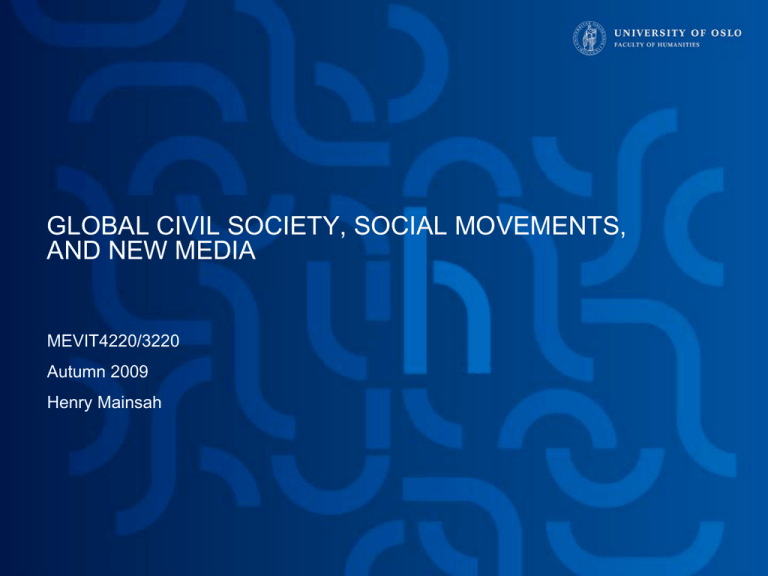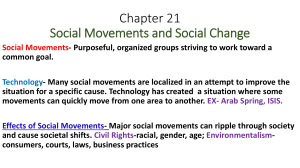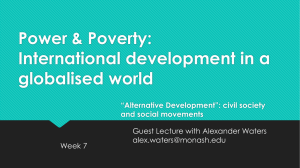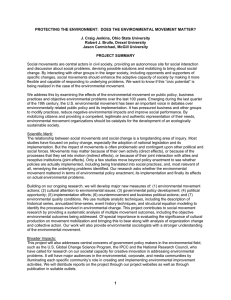Political Science and Politics
advertisement

GLOBAL CIVIL SOCIETY, SOCIAL MOVEMENTS, AND NEW MEDIA MEVIT4220/3220 Autumn 2009 Henry Mainsah Defining the context The world undergoing a process of structural transformation: technological, economic, cultural and institutional. Remember Castells’ network society: relationships of power, production and experience “are increasingly organized around networks” that constitute the new social morphology of our societies” – Informationism as the “material foundation” of a network society – “Power in the network society is communication power” – “Communication networks are the fundamental networks of power-making in society” - Castells, M. (2009) Communication Power. Oxford: Oxford University Press) 2> Department of Media and Communication Context: Crisis of political legitimacy Castells, M. (2005) “Global Governance and Global Politics”. Political Science and Politics Gallup worldwide survey for the Millenium Assembly of UN in 1999: – 62.1% of the 57.000 persons interviewed in 60 countries believed that their countries were not governed by the will of their people – When asked to select a term that would better describe their perception of their government their main choices were “corrupt” and “bureaucratic” World Values Survey conducted between 1997-2001: – Majority of citizens in countries where survey was conducted thought their governments were run by “a few big interests looking out for themselves” Gallup worldwide survey for the World Economic Forum in 2002: – Percentage of people who thought they were not governed by their will - 52% in North America, 61% in the EU – Least trusted institutions: multinational companies, parliaments, political parties, and governments. – Most trusted institutions: armed forces, UN, NGOs. “Democracy in Latin America” survey in UNDP report in 2004: 54.7% of people surveyed would prefer authoritarian regime if it would help alleviate poverty 3> Department of Media and Communication Context: The state and global politics The realities of globalization: Political crises that affect the institutions of national governance: The existence of a global economy A global media system The management of problems that surpass the jurisdiction of the state - e.g. the environment, human rights and social justice, global security Crisis of efficiency Crisis of legitimacy Crisis of identity Crisis of equity 4> Department of Media and Communication A global civil society These challenges can be in part be seen as reason behind the rise of a global civil society. Thörn (2007) defines a global civil society as “ a political space in which a diversity of political cultures interact and intersect” The concept of civil society can be related to theoretical traditions: – Locke - organizational and institutional defense of individual rights against the intrusion of the state. – Tocqueville - process of self-management of issues of the issues arising in society by people themselves, autonomous from the state, but within framework of a democratic system. – Gramsci - intermediate space between state and citizens , in which institutions and peoples’ organization may interact, exchange, and negotiate interests. Defined by relationship with the state. 5> Department of Media and Communication Trends indicative of a global civil society •Grassroots activities at the local/national level •The rise of non governmental organizations (NGOs) •Global social movements against globalization. •Movements of public opinion 6> Department of Media and Communication Grassroots activities Local organizations, community groups, labor unions, and interest groups that in every country defend local/sectorial interests, specific values against or beyond formal political process. Grassroots activities are highly diversified in different areas of the world: religion, women's groups, ecologists, community development etc. This amounts to a shift in political system to informal and formal associations of interests and values as source of collective action and socio-political influence. Strengthening of local society to face problems of unchecked globalization. Properly speaking, not global, but constitutes a milieu of organization, projects, and practices that nurture growth of global civil society. 7> Department of Media and Communication The rise of NGOs Private organizations that address global problems outside government channels. Affirm universal values. Sometimes politically manipulated by governments for their own interests Three main characteristics: 1. They often enjoy considerable popularity 2. They focus on practical matters, specific cases, and concrete expressions of human solidarity. 3. The media is used as a key battleground for campaigns. Examples: Médecins Sans Frontieres, Oxfam, Transparency International, Greenpeace etc. 8> Department of Media and Communication Global social movements A network of organizations not bound by state barriers and that connects people and places formally seen as distant or separate. (O’Brien et al. 1999) Four elements characterizing social movements (Van Aelst & Walgrave, 2002): – Network of organizations – Shared collective identity – Mobilizing through unconventional actions – To obtain social and political goals Example: the global social movement for social justice (labeled, the “anti-globalization movement) “another world is possible” 9> Department of Media and Communication Movement of public opinion The emergence of spontaneous, ad hoc mobilizations using horizontal, autonomous communications systems Examples: •The use of the Internet and cell phones as mobilization tools by the broader labor/environmental/anarchist coalition at the 1999 Seattle protests against the World Trade Organization (WTO) •The use of the Internet by movement actors to organize protests against EU immigration policies (www.noborder.org) •The spontaneous of thousands of youth in Spain in March 2004 against the manipulation of information by the Aznar government following the Al Qaeda. The use of SMSs in publicity campaign that changed the result of the election. 10 > Department of Media and Communication Strategies for political action Mobilization Internationalization - networking/collaboration Support erosion 11 > Department of Media and Communication ICTs and social movements Wim, B.H.J. Van de Donk. Cyberprotest: new media, citizens, and social movements: 1. ICTs increasingly used by various social movements to different degrees, with varying sophistication heterogeneous nature of movements reflect different levels of use. Internet used by mainly by three types of movements(a) informal networks with large geographical reach (b) big, powerful, and centralized movement organizations (c)issue-focused transnational campaigns. 2. Internet may facilitate traditional forms of protests such as rallies, demonstrations, and collection of signatures but will hardly replace these. 3. Internet allows immediate mobilization across the globe. 4. Internet serves as a tool to provide information suppressed by traditional media. 5. Internet affects internal structure of organizations - density and direction of their links 12 > Department of Media and Communication Case study www.timeforclimatejustice.org Form yourselves into groups and analyze this campaign website (Raison d’etre, content, discourse, technology use, links, strategy, implications) 13 > Department of Media and Communication 14 > Department of Media and Communication









